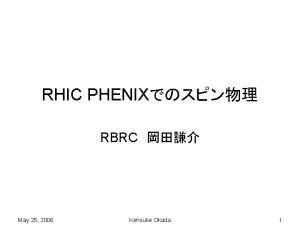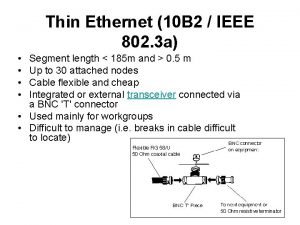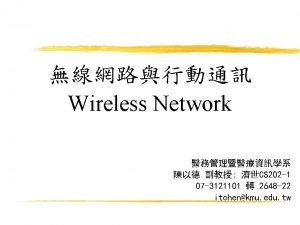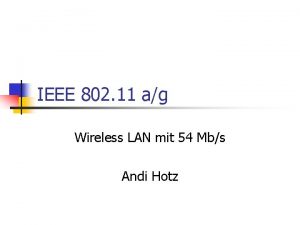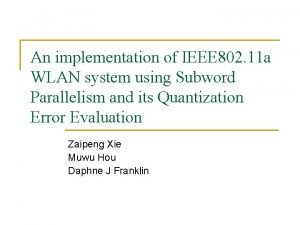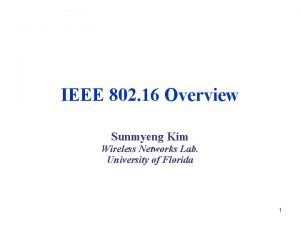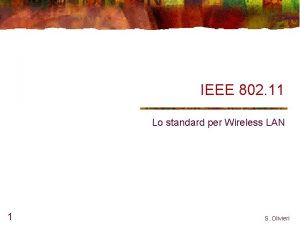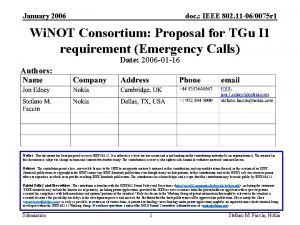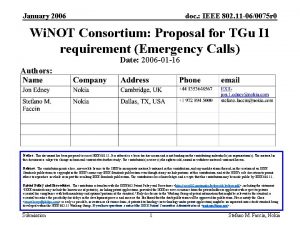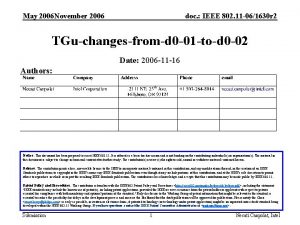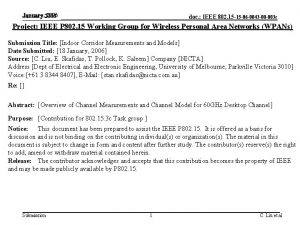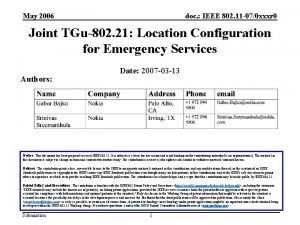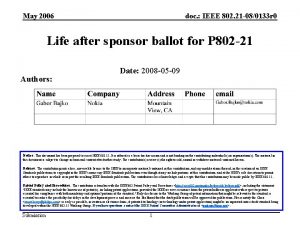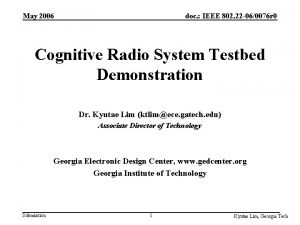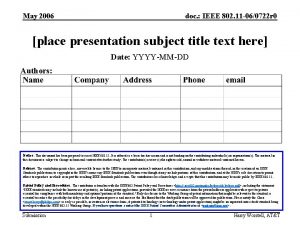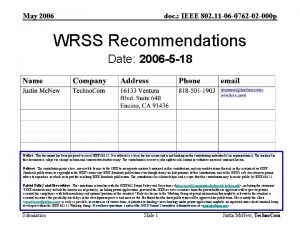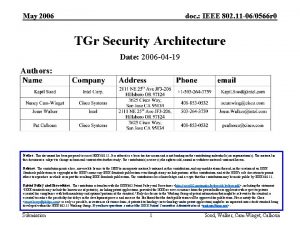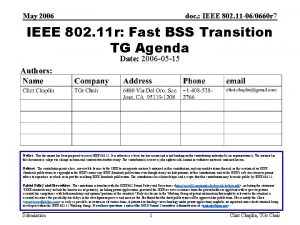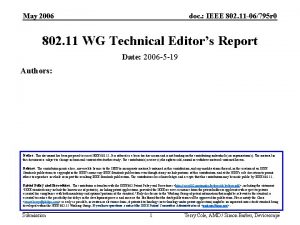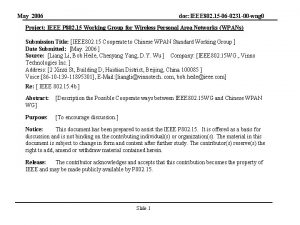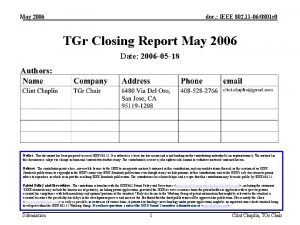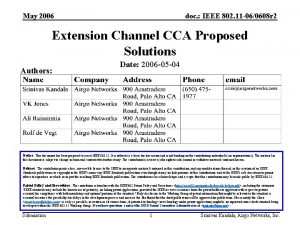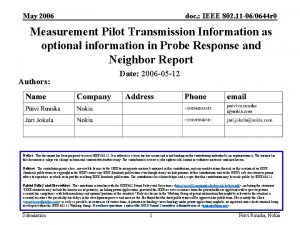May 2006 doc IEEE 802 22 060075 r





















- Slides: 21

May 2006 doc. : IEEE 802. 22 -06/0075 r 0 Performance of the Power Detector IEEE P 802. 22 Wireless RANs Date: 2006 -05 -15 Authors: Notice: This document has been prepared to assist IEEE 802. 22. It is offered as a basis for discussion and is not binding on the contributing individual(s) or organization(s). The material in this document is subject to change in form and content after further study. The contributor(s) reserve(s) the right to add, amend or withdraw material contained herein. Release: The contributor grants a free, irrevocable license to the IEEE to incorporate material contained in this contribution, and any modifications thereof, in the creation of an IEEE Standards publication; to copyright in the IEEE’s name any IEEE Standards publication even though it may include portions of this contribution; and at the IEEE’s sole discretion to permit others to reproduce in whole or in part the resulting IEEE Standards publication. The contributor also acknowledges and accepts that this contribution may be made public by IEEE 802. 22. Patent Policy and Procedures: The contributor is familiar with the IEEE 802 Patent Policy and Procedures http: //standards. ieee. org/guides/bylaws/sb-bylaws. pdf including the statement "IEEE standards may include the known use of patent(s), including patent applications, provided the IEEE receives assurance from the patent holder or applicant with respect to patents essential for compliance with both mandatory and optional portions of the standard. " Early disclosure to the Working Group of patent information that might be relevant to the standard is essential to reduce the possibility for delays in the development process and increase the likelihood that the draft publication will be approved for publication. Please notify the Chair Carl R. Stevenson as early as possible, in written or electronic form, if patented technology (or technology under patent application) might be incorporated into a draft standard being developed within the IEEE 802. 22 Working Group. If you have questions, contact the IEEE Patent Committee Administrator at patcom@iee. org. > Submission 1 Steve Shellhammer, Qualcomm

May 2006 doc. : IEEE 802. 22 -06/0075 r 0 Introduction • The purpose of this presentation is to evaluate the performance of the power (energy) detector as a method for identifying which TV channels are occupied and which are vacant • Evaluate the performance of the power detector according to the Spectrum Sensing Simulation Model [1] Submission 2 Steve Shellhammer, Qualcomm

May 2006 doc. : IEEE 802. 22 -06/0075 r 0 Power Detector • The test statistic T is an estimate of the signal power • Scale the energy detector by sensing time (equivalent) • Two hypotheses Submission 3 Steve Shellhammer, Qualcomm

May 2006 doc. : IEEE 802. 22 -06/0075 r 0 Notation Submission B Bandwidth (6 MHz) N Noise Power Spectral Density -174 + 11 = -163 d. Bm/Hz P Signal Power M Number of samples 4 Steve Shellhammer, Qualcomm

May 2006 doc. : IEEE 802. 22 -06/0075 r 0 Probability Density Function of T • For large M the central limit theorem says the density function of T is approximately Gaussian • PDF of T under H 0 • PDF of T under H 1 Submission 5 Steve Shellhammer, Qualcomm

May 2006 doc. : IEEE 802. 22 -06/0075 r 0 Select Detection Threshold • Using PDF of T under H 0 we can set our detection threshold to meet our probability of false alarm requirements • For 11 d. B noise figure, 6 MHz bandwidth and M=60 and PFA = 0. 01 • Noise power = -95. 2 d. Bm • Threshold set at -94. 1 d. Bm Submission 6 Steve Shellhammer, Qualcomm

May 2006 doc. : IEEE 802. 22 -06/0075 r 0 Probability of Misdetection • The theoretical probability of misdetection is given by, Submission 7 Steve Shellhammer, Qualcomm

May 2006 doc. : IEEE 802. 22 -06/0075 r 0 Theoretical Probability of Misdetection Submission 8 Steve Shellhammer, Qualcomm

May 2006 doc. : IEEE 802. 22 -06/0075 r 0 Theoretical Probability of Misdetection Submission 9 Steve Shellhammer, Qualcomm

May 2006 doc. : IEEE 802. 22 -06/0075 r 0 Simulation of Power Detector • Used one of the MSTV signal files Submission 10 Steve Shellhammer, Qualcomm

May 2006 doc. : IEEE 802. 22 -06/0075 r 0 Simulation of Power Detector • Converted this signal to baseband • Decimated signal by a factor of 3 • Resulting complex baseband signal has a sampling rate of a little more than 7 MHz • Applied power detector to this signal and compared results to theoretical results Submission 11 Steve Shellhammer, Qualcomm

May 2006 doc. : IEEE 802. 22 -06/0075 r 0 Simulation of Power Detector (SS 1) Submission 12 Steve Shellhammer, Qualcomm

May 2006 doc. : IEEE 802. 22 -06/0075 r 0 Simulation of Power Detector (SS 1) Submission 13 Steve Shellhammer, Qualcomm

May 2006 doc. : IEEE 802. 22 -06/0075 r 0 Average over Fading Statistic (SS 2) • Lognormal Shadow Fading Submission 14 Steve Shellhammer, Qualcomm

May 2006 doc. : IEEE 802. 22 -06/0075 r 0 Average over Fading Statistics (SS 2) • Numerically integrate PMD over fading PDF Submission Number of Samples (Sensing Time) PFA PMD M = 60 (10 s) 0. 1 0. 29 M = 300 (50 s) 0. 13 M = 1200 (200 s) 0. 1 0. 05 M = 60 (10 s) 0. 01 0. 45 M = 300 (50 s) 0. 01 0. 23 M = 1200 (200 s) 0. 01 0. 11 15 Steve Shellhammer, Qualcomm

May 2006 doc. : IEEE 802. 22 -06/0075 r 0 Multiple Independent Sensors (SS 3) • Combine results from multiple independent sensors • Simplest method for combining local decisions into a global decision – Any time a local sensor detects a DTV the global decision is that the channel is occupied, otherwise it is vacant – OR-ing together local decisions Submission 16 Steve Shellhammer, Qualcomm

May 2006 doc. : IEEE 802. 22 -06/0075 r 0 Relationship between Local and Global Decisions PLFA Probability of a Local False Alarm PLMD Probability of a Local Misdetection PGFA Probability of a Global False Alarm PGMD Probability of a Global Misdetection Submission 17 Steve Shellhammer, Qualcomm

May 2006 doc. : IEEE 802. 22 -06/0075 r 0 Relationship between Local and Global Decisions • Any local false alarm causes a global false alarm • So no global false alarm is the same as no local false alarms • Hence • Any local detection causes a global detection • So a global misdetection is the same as misdetection at all the local sensors Submission 18 Steve Shellhammer, Qualcomm

May 2006 doc. : IEEE 802. 22 -06/0075 r 0 Multiple Independent Sensors Number of Samples (Sensing Time) PGFA M = 60 (10 s) 0. 1 0. 2876 0. 0111 3. 07 10 -4 M = 300 (50 s) 0. 1309 3. 64 10 -4 4. 58 10 -7 M = 1200 (200 s) 0. 1 0. 0527 6. 03 10 -6 1. 69 10 -9 M = 60 (10 s) 0. 01 0. 4479 0. 0369 0. 0021 M = 300 (50 s) 0. 01 0. 234 0. 00194 7. 18 10 -6 M = 1200 (200 s) 0. 01 0. 106 4. 93 10 -5 5. 66 10 -9 Submission 19 PGMD (L=1) PGMD (L=5) PGMD (L=10) Steve Shellhammer, Qualcomm

May 2006 doc. : IEEE 802. 22 -06/0075 r 0 Conclusions • The power detector at a single sensor, using a practical number of samples, does not perform effectively • The power detector using multiple independent sensors shows promise • However, the power detector does not distinguish in any way between any type of signal and hence cannot distinguish between a signal from a licensed or unlicensed transmitter • This analysis assumes perfect knowledge of the noise power. We need to agree on a specification for the noise uncertainty and then develop the results under those conditions Submission 20 Steve Shellhammer, Qualcomm

May 2006 doc. : IEEE 802. 22 -06/0075 r 0 References 1. Steve Shellhammer, Victor Tawil, Gerald Chouinard, Max Muterspaugh and Monish Ghosh, Spectrum Sensing Simulation Model, IEEE 802. 22 -06/0028 r 5, March 2006 Submission 21 Steve Shellhammer, Qualcomm
 Bridges from 802.x to 802.y
Bridges from 802.x to 802.y Bridges from 802.x to 802.y
Bridges from 802.x to 802.y Ieee 802 standard
Ieee 802 standard Bluetooth ieee 802
Bluetooth ieee 802 802 ieee
802 ieee Ieee 802
Ieee 802 Ieee 802 family
Ieee 802 family Ieee 802 3 compliance
Ieee 802 3 compliance Wlan standards
Wlan standards Arquitetura ieee 802
Arquitetura ieee 802 Modelo ieee 802
Modelo ieee 802 Cooking with my mother
Cooking with my mother School year 2005
School year 2005 May 25 2006
May 25 2006 Hci patterns
Hci patterns 802-3-ethernet
802-3-ethernet 802 family
802 family Lan 701
Lan 701 Wireless lan 802
Wireless lan 802 Wlan 802
Wlan 802 Ssin-802
Ssin-802 802/11
802/11













